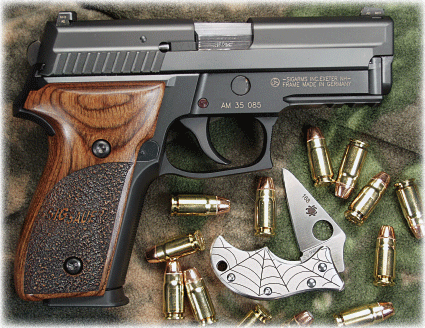A while back we looked at a pair of SIG SAUER’s current P229s, the standard DA/SA model and the relatively new DAK (Double-Action Kellermann) DAO version, both with accessory rails now common to the P229 lineup. We tested the SIGs with the .357 SIG barrels that came in them, along with an optional drop-in .40-caliber barrel. Both pistols impressed me enough to buy them at the end of the T&E sessions, both have sat in the vault since then waiting their turns for a revisit.
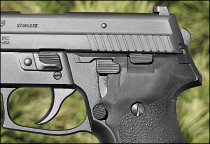 Gun Details
Gun Details
For those not familiar, the P229 is an aluminum-framed 12+1 round (in .357 SIG) DA/SA pistol where the first shot is fired from a long-travel trigger DA hammer-down carry position, and subsequent shots are fired from a cocked-hammer short-travel SA trigger position. The hammer is a rebounding type that rests on a “half-cock” notch when forward, and defaults to that notch either when the de-cocking lever is used to drop it, or when it falls on an empty chamber or dud round. The hammer never rests against the rear of the firing pin as a safety measure if bumped, in conjunction with an internal passive firing pin block that only releases the firing pin when the trigger’s pulled, and there are no external safeties. Controls are simple: a slide release to the rear, de-cocker lever just forward of that, and a magazine button where it should be about an inch below the slide release lever. The takedown lever is above the triggerguard, and breaking down a SIG SAUER pistol for cleaning is as simple as rotating that lever down 90 degrees with the slide locked open, then easing the slide assembly carefully forward off the frame, and removing the recoil spring/guide and barrel. The sights that came on my P229R were SIG SAUER’s proprietary fixed SIGLITE tritiums, the trigger was smooth-faced, the hammer spur was abbreviated to avoid snagging, and the grips were a black checkered plastic.
Custom Details
While the pistols do come out of the New Hampshire factory ready to hit the road, any mechanical device can be tweaked a bit here and there, and one of the most highly respected custom SIG shops in the country is run by Bruce Gray. A top competitor and longtime gunsmith with over 30 years of experience behind him, Bruce comes very highly recommended as a general gun surgeon, SIG certified armorer, and firearms instructor. Curious to see what Bruce could do to make an already fine P229 even finer, I recently hauled the DA/SA P229R version out of the vault, dusted it off and shipped it to Grayguns. Once there, with Scott Folk shepherding it through its time at the bench, it came back looking pretty much as it did when it left here.
Advertisement — Continue Reading Below
If you were expecting a major makeover with flashy bells, whistles, and chrome wheels, that’s not what this is about. On the outside, what Grayguns does is neither flashy nor immediately apparent. While they can refit with other types of sights, I kept the factory SIGLITEs. They’re not quite as easy on the hand in malfunction clearing as a ramped Novak style rear, but being squared at the front they do hook on the top of a belt on a downward rake for chambering a round one-handed with the slide forward on a new magazine during an emergency reload. It’s a fair trade-off. With no reason to refinish the blackened stainless steel slide, and altering the alloy frame being neither necessary nor advisable, the only obvious visible change is the now absolutely no-snag bobbed hammer spur.
Inside’s where the real work is done, and Grayguns did their Reduced Reset Comprehensive Carry Package, which includes detail polishing of every part of the pistol’s internals. Grayguns cleans up any tool marks, burrs, and “inconsistencies” as they call them, and the pistol gets a full work-over from the trigger bar pivot hole to the magazine release plunger. Reliability in a defensive pistol comes first, and the chamber, feed ramp, locking block insert, and locking surfaces on the muzzle end of the slide were polished, and the slide rails were lapped with a proprietary Grayguns tool.
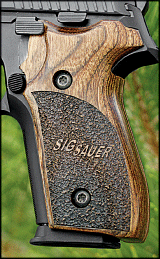 They also re-radiused the sear face and modified the original factory trigger to a custom ground intermediate trigger. Here, Grayguns re-ground the face of the trigger to a consistent radius that raises the point where the finger rests on it. The standard factory length trigger runs a trifle long for many shooters in its DA pull, and the optional factory short trigger is frequently too short for average and large hands, so the Grayguns modification leaves it right in the middle. Subtle, and you have to compare it to a non-modified trigger to make the differences apparent, but it does reduce the DA trigger travel. The reduced trigger reset option was added, and that involves welding, refitting and retiming the safety lever to decrease over-travel and reduce trigger reset time. Reduction in length typically runs about 40 to 50%, and sear engagement is also increased as a safety factor for carry. And, a 19-pound Wolff mainspring was installed. It’s the lightest that Grayguns will go (along with the caveat to test your returned pistol with your own carry ammo before you do carry it).
They also re-radiused the sear face and modified the original factory trigger to a custom ground intermediate trigger. Here, Grayguns re-ground the face of the trigger to a consistent radius that raises the point where the finger rests on it. The standard factory length trigger runs a trifle long for many shooters in its DA pull, and the optional factory short trigger is frequently too short for average and large hands, so the Grayguns modification leaves it right in the middle. Subtle, and you have to compare it to a non-modified trigger to make the differences apparent, but it does reduce the DA trigger travel. The reduced trigger reset option was added, and that involves welding, refitting and retiming the safety lever to decrease over-travel and reduce trigger reset time. Reduction in length typically runs about 40 to 50%, and sear engagement is also increased as a safety factor for carry. And, a 19-pound Wolff mainspring was installed. It’s the lightest that Grayguns will go (along with the caveat to test your returned pistol with your own carry ammo before you do carry it).
Advertisement — Continue Reading Below
Check out this article: Grayguns Enhanced Leverage System Improves SIG P-Series Triggers
All this adds up, but it’s money well spent to further improve one of the best DA autos on the market. The Reduced Reset Comprehensive Duty/Carry Package runs $285, and you can check out other packages, options, and pricing on their website, or by calling and discussing your needs.
One of the benefits of the P229R’s construction is that it’s a fairly weather and sweat resistant pistol. The stainless slide and aluminum frame are great choices for salty atmospheres, either in the air or on the skin, and the factory plastic grip panels don’t accumulate moisture under them to corrode a frame like wood can.
Advertisement — Continue Reading Below
I thought this time around on the P229R we’d expand the pistol from the concealed carry angle of the original article to a broader open carry proposition for the great outdoors. The .357 SIG is a perfectly viable caliber for the bigger cats and other assorted threats of similar size you can encounter in the woods, and there’s no reason why it can’t do both town and country duty.
We don’t have the same latitude with grip choices in an auto that we do with revolvers, but if your hand varies slightly from the “norm” in size, there are alternatives that can help. SIG SAUER now carries nicely configured laminated Super Walnut grips for the DA/SA P229 that dresses it up a little, and also increases the girth for larger hands. Laser carved with rough-out sections for traction and the SIG SAUER branding clearly lettered, I found them just a hair too big for my medium mitts, but they are very well done and if you have large hands, these could be the grips for you. They’re priced at $99.95 directly from SIG SAUER.
While black rubber doesn’t give you that warm, hand rubbed glow of beautiful wood, it also doesn’t chip, crack, stain, scratch, mildew, or warp, which means it rarely gets to looking a whole lot worse than it did when it started out new, and it anchors the pistol under recoil in all sorts of wet or dry conditions. Hogue makes two different rubber grips for the P229 pistols, and the Brownells catalog got one of each on the way. You can obviously order these directly from Hogue, but you’ll see me mention Brownells frequently as a source for parts and accessories simply because they have such an extensive inventory, and quite often they can get products enroute quicker than the people who actually make them can. When I need one source to check for what may be available for a particular gun or need, Brownells comes first. The set that will stay on the pistol, the #28010, is a normal two-panel pair with rounded and lightly pebbled surfaces, and it leaves the frontstrap of the frame exposed. The second, the #28000, is a one-piece wraparound with finger grooves that covers both the front and rear of the gripframe section. Both are very comfortable, very grippy, and their dimensions are slighty different from both of the SIG SAUER factory grips. The finger-grooved Hogues add girth again, and of the four the non-grooved Hogue rubbers were a near perfect fit in my hand. Both grips sell at $23.95 from either Brownells or Hogue.
Advertisement — Continue Reading Below
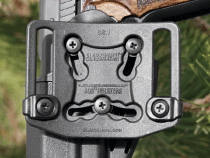 On a related note, one of my gripes about the two P229s in the original article was the factory grip screws. Then and now, I did not, do not, and will not tolerate torx-head grip screws whenever they can be avoided. Grip screws tend to loosen up on me, and I always have a slotted screwdriver blade of some sort onboard. But, since I don’t routinely carry a torx bit, I can’t tighten up a torx-headed screw in odd places if needed. SIG SAUER at the time told me they had only the torx screws for the P229s, and phone calls, e-mails, and Internet searches turned up no slotted screws. While looking through the Brownells catalog for grips for this project, I also found a set of four blue slotted-head grip screws for the P229 for a cool $5. Done!
On a related note, one of my gripes about the two P229s in the original article was the factory grip screws. Then and now, I did not, do not, and will not tolerate torx-head grip screws whenever they can be avoided. Grip screws tend to loosen up on me, and I always have a slotted screwdriver blade of some sort onboard. But, since I don’t routinely carry a torx bit, I can’t tighten up a torx-headed screw in odd places if needed. SIG SAUER at the time told me they had only the torx screws for the P229s, and phone calls, e-mails, and Internet searches turned up no slotted screws. While looking through the Brownells catalog for grips for this project, I also found a set of four blue slotted-head grip screws for the P229 for a cool $5. Done!
Holster Carry
In working a bit with BlackHawk’s SERPA line I’ve discovered they’re well designed and offer some very good features. The SERPA CQC (Close Quarters Combat) for the SIG SAUER P229 is a rigid synthetic holster that mounts either by a belt loop plate that can be adjusted for up to 2-inch belts, or by a paddle plate that’s also adjustable for different belt widths. Both plates are included, both attach or detach via three Phillips screws, and the degree of holster body cant is also adjustable on both plates.
The dual retention system is very positive on the SERPAs with a spring-loaded internal triggerguard lock that engages automatically on holstering and a backup adjustable tension screw, providing variable “squeeze” on the pistol by the holster body as needed. Unlike many other dual-retention designs, the SERPA is lightning quick and extremely simple in use. You only have to worry about one retention device, and that’s the paddle switch, which lies directly where the pad of your trigger finger will end up on the holster body as you acquire the pistol in a full-handed grip to start your draw. Push in on the pivoting switch to release the triggerguard lock, pull up, and the pistol will be in your hand where you need it without having to deal with a structured retention release combination under stress, or to re-adjust the pistol into a correct firing hold on the way up out of the holster. It’s truly a One Click convenience on the draw, and it also fits older non-railed P229s as well as the current railed P229s.
Advertisement — Continue Reading Below
Another positive about the SERPA is that there are no flex points to weaken with use and break, as there are with some other rigid holsters. The holster is also light in weight, completely covers the triggerguard of the pistol, and the front of the holster body is cut low for quick clearance.
This SERPA model is intended for concealment, but it works just as well, or better, for open carry where appropriate, and that’s why it’s included here. My only real complaint about the design, aside from the fact that there’s no leather in it, is that the way the removable mounting plates attach to the holster body leaves the pistol sitting about a half an inch farther away from the body than many conventional holsters do. This adds carry bulk to a pistol that’s already not one of the slimmest autos out there, and that may or may not be an issue for you. I’d prefer the P229 to ride closer for easier concealment, but in open carry it doesn’t make a bit of difference, and the upside is that it may create less contact between the carrier’s body and various parts of the SIG SAUER in hot weather, depending on build.
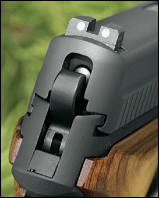 Shooting Impressions
Shooting Impressions
Since this pistol was already benched the first time we looked at it, and the Grayguns work was not intended to address accuracy, there wasn’t much point in benching it again. I did take it up the hill behind the house with some steel plates for a less formal shooting session. In either DA or SA, I had no problem clanging the plates at 25 yards freestanding, and moved back to 50 yards, where there was more of a challenge. The P229 still shoots straight, and it cycled perfectly through 120 rounds fired, with the exception of two light-strike misfires with the USA WinClean 125-grain BEB, and one with the UMC 125-grain FMC. All three fired on the second strike, and all 20 of the Hornady 124-grain JHP/XTPs that followed fired on the first strike. The trigger reset is short and quick, exactly as advertised with a 4-pound SA break, and a marked improvement over the factory trigger. Recoil is very manageable in the SIG SAUER, and the flat-shooting .357 required only minor hold adjustments from 25 yards out to 50 yards.
Advertisement — Continue Reading Below
Final Notes
Although we normally tend to regard an autopistol as a “town gun”, this SIG SAUER in its high-stepping .357 chambering is perfectly capable of hitting the trail, and with 12+1 rounds in hand and at least one spare 12-round magazine, it’s also a confidence builder when handling threats far from help when it and you may be all you’ve got to get you through. In that role, I’d prefer the .357 SIG over the .40, and far above the 9mm.
The pistol in basic form is a cut above the DA breed and Bruce Gray’s shop further refines this thoroughbred into a racer, while still retaining the stamina of the draft horse that gets the real work done. But, don’t take my word for it, find out for yourself. My only real complaint on my 229 is that the rails should be optional. And, while the Grayguns’ patent attorney wouldn’t let them give out any details, keep an eye on this outfit. In the near future they’ll be taking the SIG SAUERs even farther with their own line of high quality parts, and a confirmed prototype P220 in 10mm. They take these guns very seriously.
Got a good SIG SAUER? Now you know where to go for a better SIG SAUER.
Advertisement — Continue Reading Below
